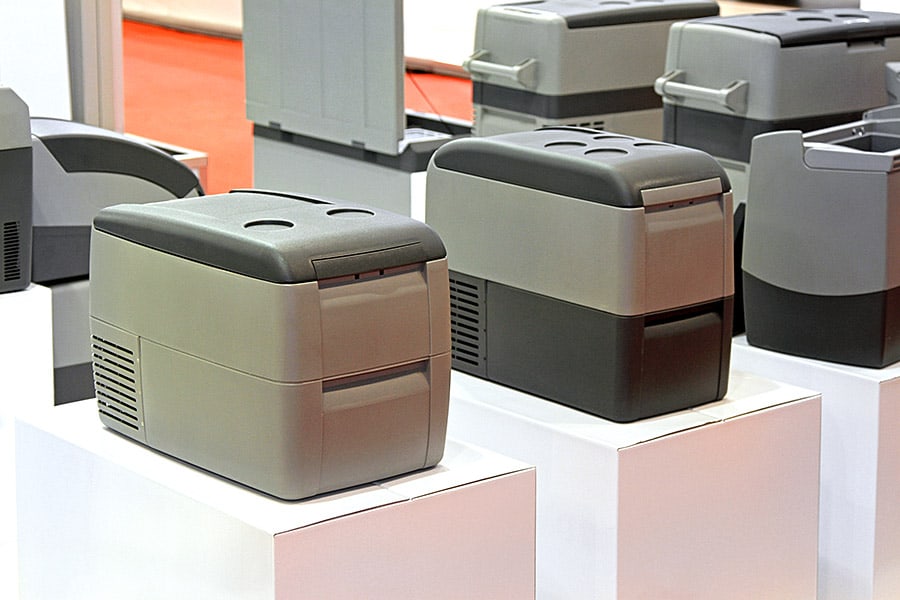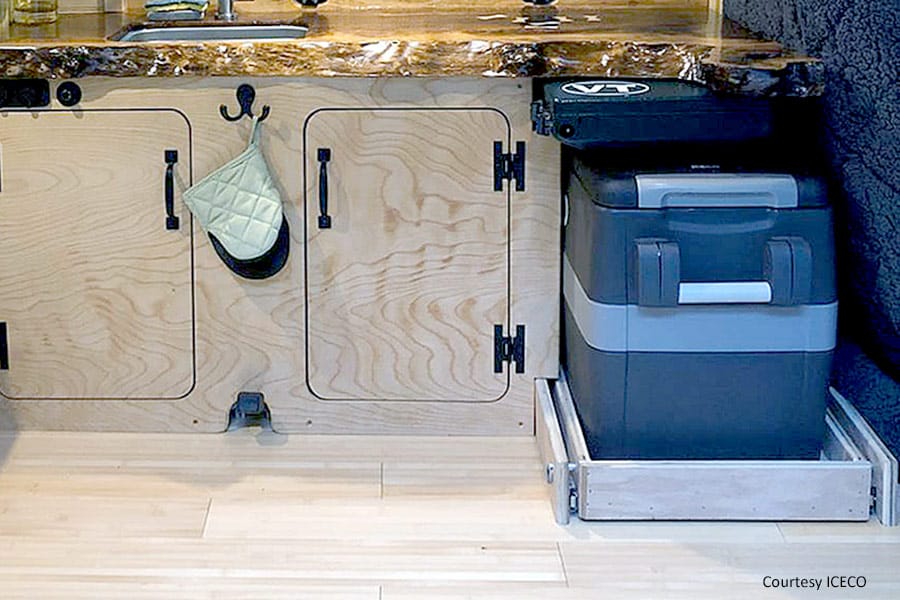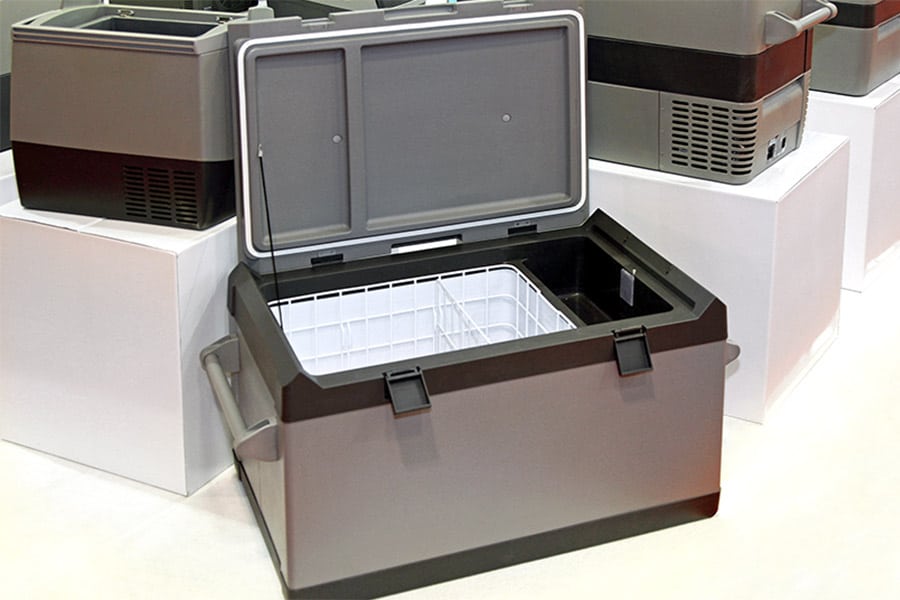
Fridges are among the most useful appliances to bring with you when you’re packing for a camping trip. There are many types to choose from; their primary function is to keep your food and beverages cold. By optimizing their performance, you can get the most out of your camping fridge.
To use a camping fridge the right way, you need to know the different types, optimal temperature, packing basics, and the best place to install it. Additionally, how to keep it colder, the importance of keeping it level, and picking the right size.
Also, you’ll learn how to take care of your fridge, tips to keep your food colder longer, and what type of power is needed.
Absorption, Thermoelectric, or Compressor Fridge – What’s the Difference
Choosing the right fridge for your camper van will be different from person to person. There are three different types available: absorption, thermoelectric, and compressor fridges. They’re all excellent options for camper vans, motorhomes, and cars. However, because of the various differences, you will probably prefer one over the other.
Let’s examine a couple of the pros and cons of each fridge type below.
Pros of Absorption Fridges
- Perhaps the best benefit of these kinds of fridges is that they’re almost entirely silent. The energy exchange process removes heat, which is a noiseless transition. If you’re traveling in a camper van for long periods, then the sound of traditional coolers and refrigerators could eventually become annoying.
- Absorption fridges generally use propane, although they can use AC and DC electricity also. If you’re trying to conserve the electricity from the battery in your camper, then using propane is an excellent alternative. It allows you to save your battery power for other uses, such as coffee machines, charging your devices, and so on.
Cons of Absorption Fridges
- You’ll need to make sure that there’s always proper ventilation when the fridge is running. The cost of using propane adds up after a while, something you wouldn’t have to worry about if you were using solar panels or another form of electricity. Without proper ventilation, propane can cause illnesses, as listed by the CCOHS.
Pros of Compressor Fridges
- Compressor fridges can keep your food cold even on the hottest of days. They’re cheap to run thanks to their energy efficiency.
- Most models allow you to freeze food also, which is a very convenient feature.
Cons of Compressor Fridges
- Compressor fridges have a fan that can be a little bit loud at times. If you buy a high-quality fridge, it won’t be too noisy. However, the average compressor refrigerator fan makes white noise for about 10 to 15 minutes per hour.
Pros of Thermoelectric Fridges
- Thermoelectric fridges are some of the toughest in the industry. With fewer moving parts, you don’t need to worry about it sliding around while you’re driving. If ruggedness is a priority, then this durable cooler will be a perfect solution for your camper van. The process of thermoelectric cooling causes a heat transfer that isn’t very easily interrupted.
- Many thermoelectric fridges can have the option to cool or heat the food and drinks inside. This option isn’t found in all other refrigerators on the list, making it a top-notch choice for winter camping.
Cons of Thermoelectric Fridges
- Thermoelectric fridges rely on the ambient temperature for their cooling ability; therefore, it can only cool down to a certain point below the temperature of where it is located.
Van Camping Life Tip: To get the optimal results when packing your fridge, cool your fridge down the day before you want to use it. Also, pre-cool all the food that you will be packing in the fridge.
Set the Temperature Correctly
Keeping your refrigerator set to the correct temperature will prevent the food from spoiling. Milk, meat, and other perishables can quickly go bad in a matter of hours if they’re not stored properly. The Food and Drug Administration (FDA) states your fridge should be at or below 40° F (4.4° C).
However, your camper van fridge temperature should be between 35 to 38 degrees Fahrenheit (1.7 to 3.3° C). That being said, the highest it can go is 40 degrees F (4.4° C) before your food starts to spoil. The reduced temperature is suggested since small fridges are subject to fluctuating temperatures based on your camper’s ambient temperature.
For example, if it’s set to 40°F, but the air in your camper is 85 degrees, your fridge could move up to 42 to 43 degrees. By adding the temperature buffer mentioned above, you should never have to worry about the refrigerator’s temperature exceeding the safety standards.
It’s important to remember that thermoelectric coolers can only reach a specific temperature below the ambient temperature. This factor makes them sometimes not ideal for a camper van or RV that will be used in hot temperatures.
According to Wikipedia, a thermoelectric camping fridge can typically reduce the temperature by up to 36 degrees Fahrenheit. Therefore if it is 100 degrees Fahrenheit in your camper van, that would mean the fridge temperature might be around 64 degrees, which is an obvious issue. Perishable items will start to spoil, making them pointless to purchase in the first place.
Other Posts of Interest
- What Is An Inverter? Why Would I Want One In My DIY Van Build?
- 11 Camping Destinations In The Allegheny National Forest
- Is It Safe To Use A Public BBQ Grill?
- 9 Perfect Places To Van Camp In North Carolina
Camping Fridge Options
There are many different fridges out there to choose from. Below are a few fridges for you to consider when getting ready to purchase.
Dometic CFX3 45-liter portable refrigerator and freezer has the option of powering with AC, DC, and solar, so no matter where you are, there is an option that you can use. Its rugged construction will stand up to any conditions. Features a built-in battery protection system that prevents dead batteries.
Alpicool CF 55 portable mini fridge freezer allows you to chill down to -4 degrees Fahrenheit. It also has a low, medium, and high battery protection setting to protect your vehicle battery.
The Alpicool mini fridge runs quiet and is perfect for a car, truck, boat, or RV.

ICECO JP50 Portable Fridge – Is a popular choice for many campers. To quickly cool the fridge down, it has a MAX mode. There’s also a battery protection system. Runs on AC or DC and comes with an insulated protective bag. The compressor has a 5-year warranty backing it.
The Dometic TC 14 is a thermoelectric cooler and is lightweight and easy to transport. It keeps contents either cool or warm, depending on what food you wish to carry.
When you set your preferences, the memory function remembers them even if you switch the unit off. You can use AC or DC to power it.
Pack Your Fridge With Frozen Goods on the Bottom
The proper packing of your camping fridge will prevent it from warming up too quickly. Unfortunately, far too many campers place everything inside without any strategy at all. You most likely will end up with soggy food, too much condensation, and food that spoils sooner than it should.
If you’re looking for packing tips, follow these three suggestions:
- Place all of the frozen goods near the middle-bottom of the fridge. Most refrigerators in campers start from the bottom, which will keep the frozen foods colder much longer. It also allows the frozen air to move upward, cooling the rest of your food and drinks.
- Separate the drinks from the food. If you can set a barrier between them, you’ll keep your food from getting wet or soggy. As drinks (such as bottled water or soda) start to condensate, the moisture can accumulate on the food. Separating them is the key to preventing such issues.
- Keep meat near the bottom of the fridge. Meat is often the least used food in a fridge since it’s not incorporated in all snacks and meals.
Install the Refrigerator in a Shaded Part of the Camper
When you’re placing your fridge in the camper van, it’s important that you secure it. Some campers already have a designated spot for refrigerators, so you can just put your new one there. However, you might have to get a bit creative.
One option is to brace it with some 1×3 inch boards. Use maple or oak wood since they’re both durable and reliable. Keep the fridge out of the direct sunlight coming through the windows, if possible. The extra heat can make your fridge work harder than it needs to.
Make It Colder With Frozen Water Bottles
Getting a camping fridge to be colder is very easy these days. Almost all of them come with settings that allow you to adjust the temperature; however, you see fit. Remember to follow the 35 to 38-degree suggestion from earlier in the post. If you’re freezing the contents, set it at around 0°F (-17°C).
Another suggestion would be to throw in a few colder items than what’s already in there. For example, if you’re putting in room temperature drinks, put in a few frozen bottles of water or ice-cold milk. Adding too many warm or mid-temperature contents to the fridge can increase the interior temperature for a bit.
If you have a split fridge, meaning that it can have a freezer and a refrigerator under the same lid or door, then you’re in luck. These combos usually stay relatively cold.
As mentioned previously, the best way to get your camping fridge colder is to lower the thermostat settings. It’s honestly that easy, in most cases. Even if your fridge has a thermometer, it might be a good idea to get a separate fridge thermometer to check the temperature from a second source.
Keep It Cold With Vent Fans, Airflow, and Low Temp Settings
Lowering the interior temperature of your fridge is one thing, but keeping it colder for a more extended period can be an entirely different battle. Luckily, compressor fridges stay cold as long as they’re plugged into a source. Using solar panels is a perfect way to keep the fridge cold as long as the panels can produce power from the sun.
If you want to keep a thermoelectric fridge colder longer, you’ll need to keep its surroundings cold. Keep the air conditioner blowing and maybe turn on a fan or two. If you can use a roof vent, such as the Fantastic Vent Fan, to pull hot air out of your camper, it will help maintain the perfect temperature.
Another suggestion is to have an alternative fuel source. Some refrigerators can use electricity or propane. Having both of them on board will allow you to switch over to whichever source is more affordable and efficient for cooling at the time. For instance, if it’s overcast and your panels are having a hard time absorbing sun rays, switch over to propane.
Van Camping Life Tip: Consider fridges that can run off both propane and electric. If you are boondocking where there is no electricity, you can power the fridge with propane.

Level Out Your Camping Fridge at All Times
Leveling a cooler or fridge in your camper van is often very necessary. Unlevel surfaces can cause various issues, but not all models need to be perfectly placed to work as they should. Thermoelectric coolers are rugged enough to withstand all sorts of difficulties, including uneven surfaces.
If your thermoelectric cooler is sitting at an angle, you’ll be able to use it just fine. The only possible concern would be ensuring that the connections aren’t loosened or moving around as you drive the vehicle.
On the other hand, absorption fridges need to be level to work correctly. Uneven absorption refrigerators can cause improper cooling, which leads to spoiled food. It can also cause the fridge to loosen its connections and become completely inoperable. For these reasons (and many others), absorption fridges must be kept level at all times.
Finally, compressor fridges should be kept level as well. The energy transfer is only optimal when it’s level, but you’ll still be able to use the fridge either way. Why not give your camping fridge the best opportunity to get the most usage out of it?
Differences Between Electric, Propane, and Combo Fridges
Electric, propane, and combination camping refrigerators are currently the only three reliable options on the market. They’re all great choices, but they’re not practical in some instances vs. others. To see the highlights and suggestions for each type, review the sections below.
Electric Refrigerator Tips
- Always check the connections of your electric fridge. Whether it’s connected to a 12V battery, solar panels, or another source, electrical connections are usually the place that most problems start. If you can keep them clean and connected, you’ll be good to go.
- Search for energy-efficient refrigerators. Compressor fridges are the most energy-efficient electric fridges on the market. You’ll be able to remain eco-friendly while also saving more money and demanding less from your fridge.
Propane Refrigerator Tips
- Try to find the best prices for propane in your area. This might seem obvious, but not all propane refill stations have the same price. If you find a good deal, get a couple of tanks rather than just one. As long as you can secure the tanks safely, you’ll potentially save money down the road.
- Always allow enough ventilation in your camper when you’re using a propane fridge. On a similar note, some RVs are prohibited from entering specific tunnels, crossing certain bridges, and even sections of roads if equipped with propane tanks. An example of this is Baltimore Harbor and the Fort McHenry Tunnels, according to the Maryland Transportation Authority site. If you are traveling to unfamiliar areas with propane, you might want to check your route ahead of time.
Combination Power Refrigerator Tips
- Combination fridges should be used wisely. Never assume that solar power is always the best choice since it’s readily available. If you find a cheap propane source, it can be better because your solar power can be used to charge other appliances and devices.
- Only get a combination fridge if you know that you’ll use both power options. When you get a combo fridge and only use one or the other, you’ll be wasting your money. Their ability to use several power options adds to the initial price tag, which ends up being a pointless expenditure if you have no plans to use one of them.
Pick the Proper Size
Just as important as the fuel source of a camping fridge is the capacity. If you get the perfect fridge, but you can’t fit everything inside, it’s pretty much useless. Everyone has different demands, but let’s check out this quick breakdown to help you get closer to your needs:
- 21-Quart camping fridges are suitable for weekend trips with a few drinks, but mostly food.
- 36-Quart fridges can have enough food and drinks for 5 to 7 days, depending on how many people are with you.
- 53-Quart fridges are better if you want to add additional drinks, such as a 12-pack.
Each camping refrigerator will have different features, do some research, and choose the one that best meets your needs.
Conclusion
Now you know all about camping refrigerators and how they work, you’ll be able to use them correctly. Camping fridges are a convenient addition to your camper van kitchen setup and aren’t all that costly. Modern camping coolers and fridges are designed for efficiency, so now you have the information to get the most out of your camping fridge.






